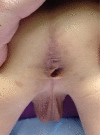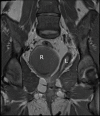Reoperative surgery in anorectal malformation patients
- PMID: 34423164
- PMCID: PMC8343547
- DOI: 10.21037/tgh-20-214
Reoperative surgery in anorectal malformation patients
Abstract
Currently accepted primary repair of congenital anorectal malformations (ARMs) includes a posterior sagittal incision, which allows for optimal visualization and identification of important pelvic structures and anatomical features. Reconstructive surgery involves meticulous dissection and separation of pelvic structures, and careful reconstruction can result in good functional outcomes for many patients, who live without ongoing sequelae from their malformation. However, some patients may require reoperative procedures for anatomic or functional reasons. Males and females present with slightly different symptoms and should be approached differently. Males are most likely to require reoperations for anorectal or urethral pathologies, but the urinary system is often spared in females-they instead must contend with Mullerian duct anomalies, of which there are many varieties. Depending on the original malformation and severity of symptoms, redo surgery may be needed to optimize function and quality of life. Surgical management with reoperative surgery in ARMs ranges from straightforward to complex, depending on the issue. One must weigh the risks of reoperative surgery and potentially creating more scarring against the need for a better anatomical and functional outcome. Current management trends and practice patterns with regards to reoperative surgery in ARM patients are not widely studied or standardized but we provide an overview of the more common pathologies, preoperative evaluation and workup required to identify the issues, and options for reoperative repair in these patients.
Keywords: Anorectal malformation (ARM); redo surgery; reoperative.
2021 Translational Gastroenterology and Hepatology. All rights reserved.
Conflict of interest statement
Conflict of Interest: All authors have completed the ICMJE uniform disclosure form (available at http://dx.doi.org/10.21037/tgh-20-214). The series “Current Topics in Pediatric General Surgery” was commissioned by the editorial office without any funding or sponsorship. The authors have no other conflicts of interest to declare.
Figures







References
-
- Stephens FD. Imperforate rectum; a new surgical technique. Med J Aust 1953;1:202-3. - PubMed
Publication types
LinkOut - more resources
Full Text Sources
